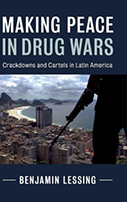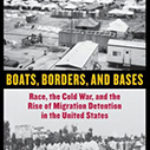Making Peace In Drug Wars: Crackdowns And Cartels In Latin America

Author: Benjamin Lessing
Publisher: Cambridge, UK: Cambridge University Press, 2018. 356p.
Reviewer: Miguel A. Cabañas | September 2019
This book is guided by a simple hypothesis: Can policies that propose total drug war crackdowns be viable? What are their effects in terms of thwarting violence? What are the “rational choices” and incentives implied in policies in drug wars and how do these affect the outcome? Using game theory, Benjamin Lessing tackles these questions using three different national cases (Colombia, Brazil and Mexico) to help him generalize about policy outcomes.
Lessing explores the complexity of state-cartel violence when specific policies are introduced. He analyzes the fight between the Colombian State and Pablo Escobar in the 1980s and early 90s, the government strategies to pacify the drug trafficking group Comando Vermelho in Rio de Janeiro until 2008, and the unconditional violence against all criminal groups used by President Calderón (2006-2012) in Mexico to disrupt cartel control and violence. Comparing the different cases, Lessing claims that unconditional violence is not effective, while conditional violence or state violence that attacks only the more violent criminal actors incentivizes cartels to switch to non-violent strategies (13).
The theoretical framework is ideal to develop this topic. Lessing employs game theory and quantitative methods to analyze different aspects of the logic of cartel-state conflict and argues that conditionality of violence in different cases took away the incentives to escalate violence. Then the second part of the book presents specific case studies that support his theory, and they are explained in their historical context, offering detailed and qualitative clarification on how the theory works with those cases. This helps us understand thoroughly the concrete application of the theory and further explains the concepts presented. Finally, the third part of the book offers the reasons and motivations for state actors to adopt conditional or unconditional repression when dealing with drug traffickers.
This conditionality of violence, as Lessing calls it, aligns incentives for both sides to achieve the policy’s goal: less violence. Governments find it easier to enact unconditional violence, because implementing conditional violence might cause citizens and political institutions to perceive it as being covert pacts with the drug trade. For Lessing, cartels use violence against the state for three different reasons: economic loss reduction, violent corruption, and violent lobbying. Criminal groups, such as the one led by Pablo Escobar, used violent lobbying against the state to reverse certain laws (i.e. extradition to the United States) (39), which this book presents as “coercive diplomacy.” Lessing also proposes the term violent corruption to describe bribes that also use violence as an incentive (Escobar’s dictum “plata o plomo” [money or bullets]). Ultimately, a general cartel strategy might include non-violent approaches as well in order to capture the state (including bribery, corruption, blackmail, vote buying, and (illicit) campaign contributions). Therefore, a so-called war can be a form of signaling forms of a larger strategy of violent lobbying or violent corruption, because ultimately, even if cartel attacks involve civilians, the message of violence is ultimately intended for the political class.
Lessing clearly differentiates inter-cartel turf wars and cartel-state conflict, even if, as he points out, sometimes these interact in complex ways — because if turf competition is fierce, competition for protection might prove to be ruthless. Lessing’s theoretical model focuses on cartel-state conflict, but he also takes into account how intercartel violence can interact with and affect this particular conflict. His main argument is that policies such as Sometimiento (voluntary rendition) used in Colombia or Pacification in Brazil create incentives for delinquent groups, who, when “given an alternative to conduct their business in less violent ways, most do” (4), while strategies such as President Calderón’s “no quarter strategy” might create, counterintuitively, more incentives for violence and even higher levels of corruption. As Lessing explains about Calderón’s war: “[w]hile these crackdowns led to expansions in state coercive capacity, they largely failed to deliver on overarching, state-building goals” (6). The Sometimiento strategy worked, according to Lessing, precisely because it was done through legal presidential policy, and not using the back-door efforts of previous policies (149). Sometimiento, for Lessing, does not represent giving up the control to criminals, but it exemplifies a signal at conditionality: “a reprieve from state repression conditional on eschewing violence” (149). This conditionality collapsed when Escobar escaped La Catedral prison and went on the run, persecuted by strange bedfellows — Los PEPES (the paramilitary group named Persecuted by Pablo Escobar), the Cali Cartel, el Bloque de Búsqueda (Special Colombian Military Forces), and DEA agents. In Rio de Janeiro, conditionality was developed through pacification programs that would announce impending security force occupations, then retake the territory without having to capture or kill drug traffickers, because the latter would choose the “hiding option” instead of fighting (194). This was done one favela at a time and the results were quite positive; reducing earlier levels of violence and starting the process of building violence- and drug- free communities.
In the third section of the book, Lessing engages the question of choosing unconditional versus conditional policies at the level of the state. He asks: “Why did pro-conditionality reform efforts succeed in Rio and Colombia, but fail in Mexico?” (244). Lessing avoids answering this in simplistic ways: Calderón was not on board with this kind of policy while other powerful individuals were. Instead, Lessing uses two concepts to analyze this point. There are logistical constraints that are crucial in conditionality (more intelligence gathering and centralized operations) and acceptability constraints (political and diplomatic costs, because negotiating peace may seem immoral) (245). In Mexico’s case, for example, effective coordination between municipal, state, and federal police was difficult if not impossible because of its historical fragmentation, according to Lessing. Also, as a high-ranking Calderón official told Lessing at a symposium, “your proposed policy is unrealistic,” maybe because of morality concerns on the part of state political actors or because of the added difficulty of trying to appease voters, US officials, or UN agencies. For Lessing, ultimately, there are three factors in arriving at a conditional solution that need to be overcome in order for it to work: first, reframing the problem from fighting drug trafficking to dealing with drug-related violence; second, creating conditions of political and institutional cohesion both at the level of repressive agencies and across levels of government; and finally, the ability to build support for conditional policies through a process of trial and error since contextual factors might limit or even derail the application of conditional approaches.
As Lessing points out, repression of drug organizations helps to build stronger states, but also creates more incentives for corruption (sometimes even corrupting security forces that had not been previously corrupted, like the Mexico’s military). According to the author, policy recommendations have trade-offs and they also need to engage with what is possible politically. Lessing does not offer one-size-fits-all policy solutions, since he knows that policies have trade-offs. If unconditional repression is used, then cartel-state violence and corruption will increase, but if there is conditional repression (or violent state repression of the most violent criminal groups) then corruption and drug flows might continue undisturbed. Lessing clearly suggests that state policies both create the drug market and directly influence the levels of violence through the use of crackdowns. His first recommendation is that policies do not harden, so policy makers can experiment with new strategies; second, he sees a need to reframe this policy problem: “from eradicating drugs or crushing the cartels or punishing dastardly traffickers, to minimizing the harms produced by the drug trade” (295). So, because he considers that repealing the global drug prohibition is not realistic, he proposes “to implement and sustain conditional repression” whenever possible to achieve this goal (296). This means to implement state violence only against the most violent criminal actors and only when needed, and to get away from unconditional violent crackdowns on the drug trade. This also means eliminating state leaders’ incentives to have “hard-core” responses in the drug war because they receive more approval for being “hard on crime.” This point is actually underdeveloped here, since one of the issues of the drug wars is how to back up from hardened solutions that have been widely accepted as being effective. Lessing never truly explains how to help create public support for less violent solutions. To the claims by drug warriors that their purpose is to minimize drug flows and criminal violence, he finds no real evidence in the available data that unconditional crackdowns help, as in the case of the Calderón drug war years, where drug prices have continued to decline and the violence has continued to rise (292-293).
The main weakness in this book is that the author seems not to consider legalization and different levels of decriminalization as a real viable policy alternative that might redirect issues of violence or corruption altogether. This, however, is something that might go beyond the scope of this study on state-cartel violence — and particularly, the study of policies in countries that have not been overrun by cartel influence and violence. Maybe there is another book waiting to be written on comparative cases of legalization or decriminalization laws, and how that strategy transforms the relations established in societies with violence related to the drug trade. This book indeed hits the nail on the head on how violence is produced by the incentives of the drug wars and prohibition laws and how this violence is greatly amplified by state actions and policies. The debacle of violence and chaos from Calderón’s unconditional violence toward cartels has brought deadly consequences to Mexican society, with nearly three hundred thousand violent deaths since 2006 and more than thirty thousand people disappeared. Lessing’s study shows that governments need to be strategic to create policies that will have better outcomes, and not just think that using force can magically provide the expected results of violence quenching. Instead, state violent repression simply creates larger levels of disorder and chaos.
Miguel A. Cabañas, Associate Professor of Latin American, Global and Chicano/Latino Studies, Michigan State University


